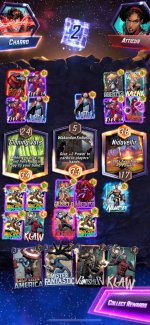A lot of video games have made me laugh this year. Trombone Champ had me rolling on the floor from the moment I first heard its nasty toots on my Twitter timeline. I got some good chuckles from hearing Rabbid Mario rattle off Italian gibberish in Mario + Rabbids: Sparks of Hope. The Stanley Parable: Ultra Deluxe slayed me with its sharp meta humor, only to crush my soul with its damning satire on the current “content era.”
Though no game released this year has me laughing as consistently as Marvel Snap. That might be a confusing claim at first glance considering the mobile release is a collectible card game built around turn-based strategy. Plopping down cards with superhero art on them to try and out-math your opponent to win zones doesn’t exactly sound funny on paper.
However, Marvel Snap excels at comedy in two important ways. One is intended, with clever in-jokes about Marvel’s mightiest heroes baked into card abilities. The other is a more emergent form of comedy, one that turns every battle into a series of pranks where players have to one-up each other to win.
That’s comedy!
The more you know about Marvel heroes heading into Marvel Snap, the funnier it’ll be right out the gate. Each superhero card comes with its own specific ability that represents the character in some way — and often it’s a small joke. Ant-Man is a measly one-power card, but when three other cards sit around him, he gets an additional three power, implying that he’s grown into Giant Man. Meanwhile, Squirrel Girl has the power to summon common squirrels in zones, which is delightfully silly the first time you encounter it.

Locations have some similarly subtle comedy to them. I get a chuckle out of the fact that playing a card at Fisk Tower immediately destroys it, as if Kingpin’s goons are waiting at the door to ambush any unsuspecting superhero who waltzes in. There’s also the Washington D.C. location, which automatically grants cards with no abilities or special skills three power. I’ll let you draw your own conclusions about what that gag is getting at.
While those little jokes make for some good smirks, what really has me laughing while playing Marvel Snap is the almost accidental comedy that comes from the game’s myriad of interactions colliding. The card game is all about strategically playing around both card and location abilities, trying to find smart ways to get the most out of the hand you’re dealt in every circumstance. The key to victory is a flexible approach that’s open to experimenting rather than trying to execute the same strategy over and over.
The more I step outside of my comfort zone and say “What happens if I do this?” the more I find myself stumbling into absurd plays. A recent example came from this when playing a round that featured the Cloning Vats location, which duplicates any card that’s played on it. To start one game I played a Rocket Raccoon card, which gets two extra power if the opponent plays a card there, too. My little buddy was buffed up to a three-power card and another was placed in my hand. I decided to push my luck by playing it there again, which is when my opponent made a counterplay with Elektra, killing a one-cost card.
Big mistake.
What followed was an almost troll-like back and forth where I’d play a Rocket clone, it would gain another two power because my opponent played an Elektra card to counter it, Elektra would kill Rocket, and he’d return to my hand with even more power. That cycle repeated a few times, until I suddenly had a one-cost, 10-power card that I could play on my fully open Cloning Vats. I won the game after playing four clones of Rocket Racoon total, giving me forty power between them. It felt true to the character: a snide jerk that would be laughing his tail off in that situation. I couldn’t help but laugh at the absurdity of it all.
That experience is common in Marvel Snap, which is why you may be seeing players tweeting out screenshots of some of their games these days. Unbelievable things tend to happen in a round and you can’t help but want to share them, even if just to have someone confirm that you didn’t hallucinate some absurd play. When one round ended with me summoning six tigers by augmenting White Tiger’s reveal ability, I rushed to take a screenshot and send it to some friends to chuckle at the mess I’d created.
It’s the eye of the tiger / it’s the thrill of the tiger. pic.twitter.com/319heIlPK7
— Giovanni Colantonio (@MarioPrime) November 2, 2022
Those moments are what have kept me coming back to Marvel Snap every day since its launch. Any time I load it up, I run into some sort of absurd, trolling setup that just has me laughing. Anytime I see someone drop a Hulkbuster on Bar Sinister, creating four copies of it and forcing me to sit through a long loop of animations as they all reinforce one another, it feels like someone is playing a good prank on me. I have no choice but to up my game and hit them with one better.
Marvel Snap is now available on iOS and Android.




